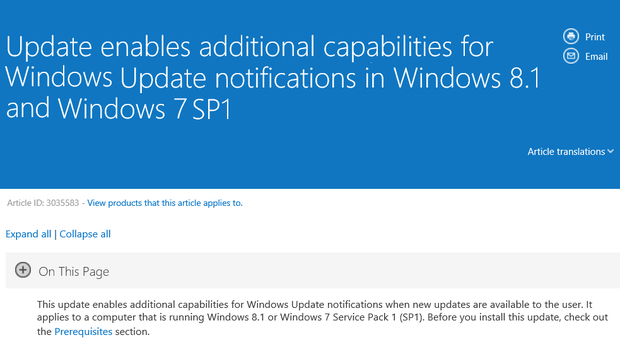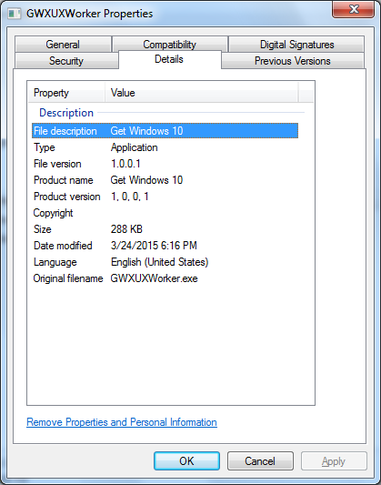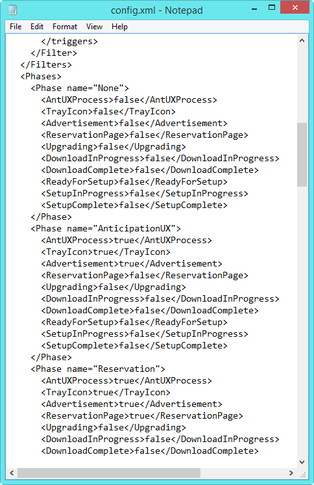Microsoft hides a Windows 10 Easter Egg in Windows 7/8.1 systems

Is something sinister afoot? I think not.
If you've been paying attention to news surrounding the KB3035583 update, you might think that Microsoft is up to no good by planting nefarious Windows 10 advertisements deep into Windows 7/8.1 systems. Some are even calling it Nagware or Adware. However, I'd say this is more akin to an Easter Egg. Let's take a closer look.
KB3035583 comes to Windows Update
At the beginning of April, (Easter weekend, mind you) Microsoft added KB3035583 to the Windows Update stream for Windows 7/8.1 systems. This small update (under 500 KB) was added to the Important Updates list on Windows Update for Windows 7 and 8.1 systems. It is also listed as a Recommended Update (Figure A).
Figure A

KB3035583 shows up in Windows Update as an Important Update.
If you follow the link to the Microsoft Support site, you'll find that the article is innocuously titled Update enables additional capabilities for Windows Update notifications in Windows 8.1 and Windows 7 SP1, and the description lacks any additional information whatsoever (Figure B).
Figure B

The Update description doesn't provide much information.
As such, chances are that most users installed it without a second thought. I know that I did. After all, we get Windows Update notifications on a regular basis, so something being described as providing additional capabilities sounds useful.
Details uncovered
Soon after the update appeared in Windows Update, the internet was aflutter when a post on a German website uncovered the real details inside the KB3035583 update (English versions also soon appeared). Yes, the patch really is about enabling additional capabilities for Windows Update notifications, but the notifications are centered on Windows 10, and reminding you that you're entitled to a FREE upgrade to the new operating system. Presumably, the update will lay dormant until Windows 10 reaches RTM. Then, the notification system will begin letting you know the status of the release as it progresses through the various stages. It will then guide you through the upgrade process. How this will work in reality and what it will look like remains to be seen.
The article revealed that when the update is installed, it creates a folder called GWX in the C:\Windows\System32 path. The GWX folder contains nine files and a subfolder titled Download that contains another three files (Figure C).
Figure C

The GWX folder contains nine files and a subfolder.
As you can see, there are a series of four executable files, a pair of XML files, a DLL file, a Security Catalog file, and a LOCK file. It's hard to tell what these files will actually do, but if you investigate the properties of the GWXUXWorker.exe file, you'll see that the description of the file is Get Windows 10 (Figure D). This indicates that the intention of the update is to assist users in obtaining Windows 10.
Figure D

The Description on the GWXUXWorker.exe file is Get Windows 10.
If you investigate the Config.XML (Figure E), you'll see that the main content of the file consists of code blocks that are titled in phases. Beginning with None (presumably the dormant phase), you can see the phases play out the initial stages: AnticipationUX, Reservation, Reserved, RTM, and GA. I can imagine that during the AnticipationUX phase, there will be feature teasers very much like what you see during the Windows 8.x installation procedure. During the Reservation phase, you'll be prompted to reserve your copy of Windows 10. During the Reserved phase, you'll be informed that your copy has been reserved and that you'll be in the first group to get Windows 10. Next, you'll be informed when Windows 10 is Released To Manufacturing and when it is Generally Available.
Figure E

The contents of the Config.XML indicate that the notification will keep you apprised of the status of the release and the actual upgrade.
During the UpgradeDetected phase, I assume that you'll be alerted when you can download your copy of Windows 10. Once you initiate the download, the rest of the phase will track your progress and the outcome of the upgrade: UpgradeDownloadInProgress, UpgradeDownloaded, UpgradeReadyToInstall, UpgradeReadySetupInProgress, UpgradeSetupCompatBlock, UpgradeSetupRolledBack, UPgradeSetupFailed, and UpgradeSetupComplete. Again, this is speculation on my part. How it actually plays out and what it will entail remains to be seen.
Easter Egg?
Of course, the goal of this update is to notify you of and promote Windows 10, but I really think that it's more like an Easter Egg than Nagware. To begin with, the update appeared Easter weekend. The update is hidden in the Windows 7/8.1 operating system, much like Easter Eggs of the olden days. Once the notification operation commences, who knows what other pleasant, unexpected, or entertaining surprises will come with it!
What do you think of the KB3035583 patch? Share your opinion in the discussion thread below.

